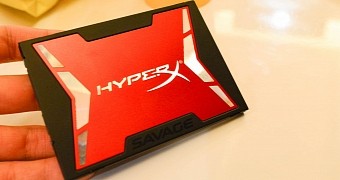Once, SandForce (later bought by LSI) was the only company that had SSD controller chips capable of attaining a transfer speed of over 500 MB/s, for both reading and writing, but this has changed. Kingston was quite satisfied to prove it, even if it wasn't its actual goal.
During the Consumer Electronics Show that took place last week in Las Vegas, Nevada, Kingston introduced some new Solid State Drives, like so many other companies did.
Some of those drives we've already seen, such as the HyperX Predator units of M.2 form factor that sell with (or without) PCI Express riser cards.
The other range of SSDs is called HyperX Savage and is tame in comparison, sticking to the more familiar, conventional 2.5-inch shape.
The Kingston HyperX Savage SSD series
Like pretty much every other consumer 2.5-inch SSDs these days, the drives have 7 mm-thick forms, or more appropriately “thin” since other SSDs, and especially HDDs, can be a lot thicker than that.
The storage devices are constructed with 19 nm MLC (multi-level cell) NAND Flash memory chips and the Phison S10 series controller.
This chip can read data at 560 MB/s and write it at 540 MB/s, which is about as good as you can expect 2.5-inch SATA units to work.
There are a few drives out there which are faster, on paper anyway, but even they only manage 15 MB/s more or so.
Besides, real world performance doesn't often go all the way to that level, and you're unlikely to see a difference in the way your system runs regardless. Applications will still launch instantly (provided runtime files are stored on the SSD and not a larger, secondary HDD), and even the OS will boot immediately.
Availability and pricing
The Kingston HyperX Savage solid state drives will be available with 240 GB, 480 GB and 960 GB capacities and SATA 6.0 Gbps connectors, and they will be put up for sale in March. Or at least should. That's one month later than the HyperX Predator M.2.
Perhaps this is a hint that a new range of laptops is coming in early spring, although we would expect the M.2 format to be more prominent there from now on.
Then again, those drives will be quite expensive no doubt, given their PCI Express-based performance of well over 1 GB/s, so they'll probably be used in ultrabooks and high-end notebooks, leaving mainstream mobile systems to the same old 2.5-inch SSD product type that the HyperX Savage belongs to.

 14 DAY TRIAL //
14 DAY TRIAL //